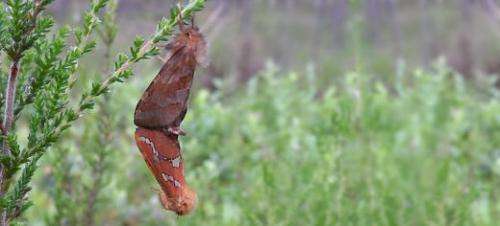Variety is the spice of humble moth's sex life

A small brown moth has one of the most complex sex lives in the insect world, new research has found.
The twilight courtship rituals of the gold swift moth (Phymatopus hecta) can be seen in summer across northern Europe and Asia, from the British Isles to Japan.
Despite the insect's unassuming appearance, a new study published in the Biological Journal of the Linnean Society reports a variety and complexity in its mating patterns and sexual positions worthy of an insect Karma Sutra.
Professor John Turner, Emeritus Professor in the University of Leeds' School of Biology, said: "With most insects, you expect to find a fairly set mating process. In moths like this, you might see the female staying still, emitting a scent and then mating with the first male moth to arrive.
"The love life of the gold swift moth is a veritable Karma Sutra of mating patterns and positions. Colleagues have commented that this is the most elaborate mating procedure known in any insect and I have certainly not observed anything to surpass it."
Professor Turner identified an array of different courtship "dances", with some individuals able to switch to alternative methods if their first gambits were frustrated:
- The female hangs from the foliage, emits a scent and mates with one of the males that arrive. This is a classic moth mating pattern.
- The male hangs from foliage, the female flies to him and they mate.
- A group of males forms a hovering swarm. Females fly past and males fly out of the swarm to follow them. When the female lands by hanging under a leaf, a male lands next to her and mates.
- A mutual courtship dance: a female flies up to a hovering male and they "dance" in the air together.
- The male hangs from foliage and a female flies in and hangs some distance away, fanning her wings to propel scent toward him. The male tends to show no interest until the female flies over to "nudge" him. He then flies off and returns to mate with her.
- The female flies at a hanging male, bumps into him, and lands a short distance away. The male then flies over the female and hangs fluttering next to her. Then the moths mate.
Professor Turner also observed frequent "fighting dances" between males and occasional "homoerotic" courtships, where males embarked on mating procedures with members of their own sex. He suggested that the latter might have been triggered by scent from nearby females confusing the males.
There were so many courtship patterns that categorising them became difficult. Professor Turner said: "I intervened on some occasions to stop the mating. The insects would pause and then resume using a different pattern. It started to look a bit like a human courtship, with the moths doing it every which way and having a whole range of tactics for attracting a mate."
There was also unexpected variety in the moths' sexual positions. Unlike most insects, which stick rigidly to a single position, the gold swift moth had two approaches:
- The male hangs facing the female and reaches over to connect his abdomen to hers. Once they connect, he lets go, falling like a trapeze artist so that he is hanging upside down from his mate. He stays in this position until the following sunrise.
- The male hangs with his back to the female and bends his abdomen backwards. They twist round to connect their bodies and then untwist as he falls into the mating position.
Variations on the two main positions were also observed.
The paper concludes that the complexity is evolutionarily stable and has probably persisted in the species for tens of thousands of years. An individual moth that limited its mating approaches—for instance, a female losing the ability to produce scent—would reduce its mating options.
Discover the latest in science, tech, and space with over 100,000 subscribers who rely on Phys.org for daily insights. Sign up for our free newsletter and get updates on breakthroughs, innovations, and research that matter—daily or weekly.
A possible explanation for the complexity of the moth's sex life may be the relative scarcity of its mating grounds, which means that both males and females congregate together in restricted areas. This confused environment may encourage the development of a variety of ways of finding a mate, using both visual and olfactory stimuli.
Professor Turner conducted the study during holidays in the north of Scotland.
He said: "I was doing the washing up and I looked out of the kitchen window to see all this happening in the vegetation in front of me. Over the next seven years, I studied it every time I came to Scotland. One of the reasons this has not been reported before may be that it happens in the twilight. There are not that many people looking at insects at that time: all the butterfly people have gone to the pub and the other moth people haven't switched their torches on yet."
More information: John R. G. Turner, 'The flexible lek: Phymatopus hecta the gold swift demonstrates the evolution of leking and male swarming via a hotspot (Lepidoptera, Hepialidae)' is published in Biological Journal of the Linnean Society 2014 onlinelibrary.wiley.com/doi/10.1111/bij.12411/pdf
Provided by University of Leeds

















